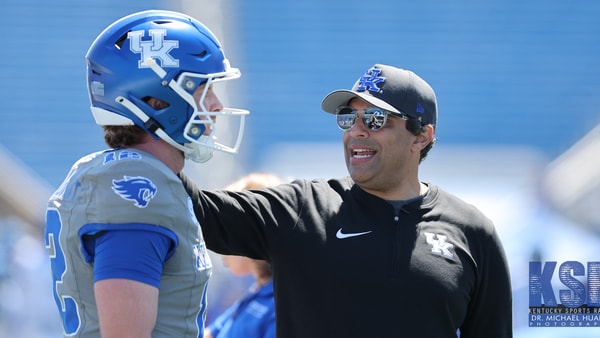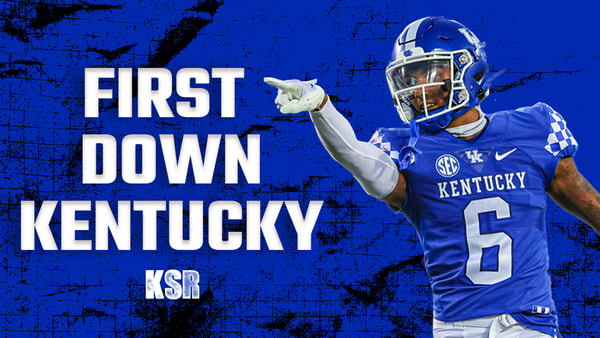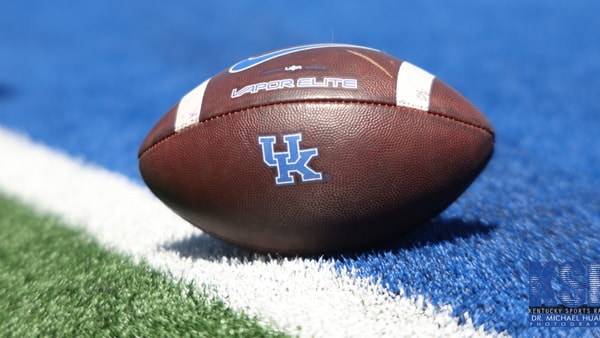
When most of Big Blue Nation was focused on March Madness box scores and scouting reports, you probably missed a potentially game-changing announcement regarding Kentucky's other iconic sport.
A few weeks ago, the typically staid, blue-blooded institution that is Keeneland took a brazen and ballsy step by
declaring that it would run a limited number of Lasix-free races in 2016. If this PED-ban experiment takes off down the home stretch, it could help rescue the thoroughbred business, currently suffering from a dramatic decline in popularity. And next spring, when you head out to the track, dressed to the nines to sip whiskey, sample burgoo, people watch, and lose a few $2 bets, you may just be witnessing the sport's rebirth.
* * *
Unlike Kentucky’s other signature industries–tobacco, coal, and bourbon–the thoroughbred business (with its kissing cousin, gambling) has operated in the Bluegrass State under a hallowed sheen of due dignity, even reverence. The horse itself is a gallantly constructed, sturdy and noble figure; the competition among its fastest peers has long been nicknamed the “sport of kings.” And our two classic racetracks shatter the grungy stereotype, each offering sublimely sacred bucket list moments for even the most casual sports fan: from jaunting through Keeneland’s fashion-conscious, floral-festooned luxury on a crisp fall weekend, to sipping a Derby mint julep under Churchill Downs’ twin spires on the first Saturday in May.
Our commonwealth’s connection to the thoroughbred, of course, is more than just spiritual. Horse racing has been quite lucrative,
responsible for creating more than 100,000 jobs in the Bluegrass State, with a $4 billion economic impact.
So it's no wonder that a 2011 McKinsey and Company
report which vividly depicted racing's economic free fall set off much wailing and teeth-gnashing all over Kentucky, and not just from the horsey-set’s mouth. The study revealed that during the first decade of the new millennium, attendance dropped 30 percent, while money bet on races declined 37 percent. Only 22 percent of Americans surveyed had a positive impression of the sport, while less than half of racing
fans would recommend it to others. If the pattern continues, the report warned, owners’ profits could be cut in half by 2020.
Worse yet, as exposed most comprehensively and graphically in an
award-winning New York Times 2012 feature
series, “Death and Disarray at America’s Racetracks,” the challenging new economics of racing has transformed an already perilous sport into an even more dangerous physical proposition for both animals and jockeys. As the Grey Lady
reported, 24 horses die every week on average at American tracks; and over a three-year period, 6,600 horses broke down during a race or showed signs of injury. Just during the
most recent winter meet at New York's Aqueduct winterized inner dirt racetrack, a dozen race horses broke down and had to be euthanized during a 22 day period, a rate of death more than four times the national average. The threat to human life, naturally, has spiked as well: The Jockey’s Guild currently assists more than 50 jockeys who have been permanently disabled by track injuries.
The problem is, in significant measure, the result of a familiar phenomenon in sport: the abuse of performance-enhancing drugs. While the impact on human athletes who voluntarily submit themselves to potential long-term risks remains the subject of
vigorous debate, the much more morally perverse practice of doping unwitting horses has a clearly tangible and immediate impact on animal welfare.
While most horse-drugging violates the sport’s rules–from overusing painkillers to mask injury, to trainer experiments with prospective performance-boosters–
lax regulations, insufficient penalties, and ineffective testing regimes have done little to deter these practices which pose serious risks to equine health.
Even more concerning is the use of one performance-enhancing drug that is administered
legally at every racetrack across the country:
Furosemide (once called Lasix, now known as Salix), a diuretic that is prescribed to help prevent bleeding in the lungs. While
research indicates that less than 5 percent of thoroughbreds bleed extensively enough to require the drug’s administration, nearly 95 percent of North American thoroughbreds are injected with it for race day. It’s simply about winning:
Studies show that horses that use the drug run on average three to five and a half lengths faster.
Moreover, new research suggests that Furosemide may have no therapeutic value at all. Dr. Gregory Ferraro, a recently retired track veterinarian who served at the U.C. Davis School of Veterinary Medicine as its Center for Equine Health director and associate director of its Large Animal Clinic,
reports that investigations in Hong Kong and Australia lay “aside the argument that the use of race day Lasix is necessary to protect the health and welfare of race horses… Of those few horses that experience serious [lung bleeding], most veterinarians would agree that Lasix is certainly not going to help these horses. They would be considered to be suffering from a pathological condition and require more serious medical treatment combined with extended rest.”
Meanwhile, the
physical impact on the horse can be dramatic. Within 24 hours after injection, a typical horse loses 35 to 100 pounds, mostly water weight. The leaner animal can run much more quickly, but strenuous exercise can lead to severe dehydration, dramatically increasing the risk of injury. Further, Furosemide is known to mask other, far more potent performance enhancing drugs, such as snail venom and risky new chemical compounds being manufactured around the globe.
The evidence for its deleterious impact indeed is so compelling that every racing jurisdiction outside of North America bans the use of Furosemide on race day. Animal welfare advocates have decried these doping practices for years. But momentum for true reform only emerged recently, when those with most at stake understood the need for action. Within the past few years, a grassroots coalition of thoroughbred breeders and owners joined to seek the passage of federal legislation to ban the practice of race-day medication, and formed the
Water Hay and Oats Alliance (the befuddling name is explained by its clever acronym: WHOA).
Arthur Hancock, a WHOA leader and industry titan who's bred three Kentucky Derby winners among his trophy case-load of champions, credits much of the movement on the McKinsey study, which revealed an
explicit connection between public concern over doping and declining attendance and betting: "Fans don't want it; it keeps the big betters from betting...The owners who are paying all of the bills finally realized that we need to do something.”
The horse industry vanguard Jockey Club cautiously jumped on the race-day medication ban bandwagon shortly after publication of the
Times series. But its initial call for local regulations in each of the 37 states that host tracks was met with predictable, race-to-the-bottom reluctance from policymakers who fear that stricter rules would drive racehorses to other states. Just last year, however, the Jockey Club admitted that its approach was no longer sufficient. The organization's chairman, Ogden Mills “Dinny” Phipps,
announced on August 10 that the organization would push for federal regulation if uniform drug rules are not passed by the states.
A possible federal vehicle is
legislation sponsored by Senator Tom Udall (D-NM) and Congressman Ed Whitfield (R-KY) that bans same-day race medication. Instead of relying on state agencies, the bill would require random testing, stiff penalties for cheating and empower the U.S. Anti-Doping Agency (USADA) to develop rules and create anti-doping education, research and testing programs.
The Udall/Whitfield approach, however, poses its own set of hurdles. Enlisting a private association such as USADA to regulate state and local entities raises a number of practical, if not constitutional, concerns. And from a political perspective, it's hard to imagine a Republican Congress seizing state regulatory functions to create a new federal bureaucracy.
Moreover, as Hancock warns, the status quo will be fiercely protected by those who profit from an annual
$100 million stream of drug payments: veterinarians and pharmaceutical companies–some of whom financially
prop up leading equine lobbying organizations such as the American Horse Council.
So the solution may indeed come from the marketplace. And should Keeneland's 2016 trial experiment prove successful, it could spawn imitators across the country.
The good news is that the fight to protect the majestic thoroughbred is no longer seen as part of an extremist agenda. As Wayne Pacelle, CEO of the Humane Society of the United States, suggests, “the Jockey Club’s support for legislation… signals that momentum is building for reform. The future of the sport may depend on its ability to embrace change and accept a new, level playing field free of the undue risks inherent in its current reliance on doping.”
As more horse industry leaders have come to understand, the battle against risky shortcuts is now a war for the sport’s very salvation. If horse racing endures and survives, it will be the result of an overdue focus on the august animal that defines the pastime.
An earlier version of this article appeared at The Daily Beast  When most of Big Blue Nation was focused on March Madness box scores and scouting reports, you probably missed a potentially game-changing announcement regarding Kentucky's other iconic sport.
A few weeks ago, the typically staid, blue-blooded institution that is Keeneland took a brazen and ballsy step by declaring that it would run a limited number of Lasix-free races in 2016. If this PED-ban experiment takes off down the home stretch, it could help rescue the thoroughbred business, currently suffering from a dramatic decline in popularity. And next spring, when you head out to the track, dressed to the nines to sip whiskey, sample burgoo, people watch, and lose a few $2 bets, you may just be witnessing the sport's rebirth.
* * *
Unlike Kentucky’s other signature industries–tobacco, coal, and bourbon–the thoroughbred business (with its kissing cousin, gambling) has operated in the Bluegrass State under a hallowed sheen of due dignity, even reverence. The horse itself is a gallantly constructed, sturdy and noble figure; the competition among its fastest peers has long been nicknamed the “sport of kings.” And our two classic racetracks shatter the grungy stereotype, each offering sublimely sacred bucket list moments for even the most casual sports fan: from jaunting through Keeneland’s fashion-conscious, floral-festooned luxury on a crisp fall weekend, to sipping a Derby mint julep under Churchill Downs’ twin spires on the first Saturday in May.
Our commonwealth’s connection to the thoroughbred, of course, is more than just spiritual. Horse racing has been quite lucrative, responsible for creating more than 100,000 jobs in the Bluegrass State, with a $4 billion economic impact.
So it's no wonder that a 2011 McKinsey and Company report which vividly depicted racing's economic free fall set off much wailing and teeth-gnashing all over Kentucky, and not just from the horsey-set’s mouth. The study revealed that during the first decade of the new millennium, attendance dropped 30 percent, while money bet on races declined 37 percent. Only 22 percent of Americans surveyed had a positive impression of the sport, while less than half of racing fans would recommend it to others. If the pattern continues, the report warned, owners’ profits could be cut in half by 2020.
Worse yet, as exposed most comprehensively and graphically in an award-winning New York Times 2012 feature series, “Death and Disarray at America’s Racetracks,” the challenging new economics of racing has transformed an already perilous sport into an even more dangerous physical proposition for both animals and jockeys. As the Grey Lady reported, 24 horses die every week on average at American tracks; and over a three-year period, 6,600 horses broke down during a race or showed signs of injury. Just during the most recent winter meet at New York's Aqueduct winterized inner dirt racetrack, a dozen race horses broke down and had to be euthanized during a 22 day period, a rate of death more than four times the national average. The threat to human life, naturally, has spiked as well: The Jockey’s Guild currently assists more than 50 jockeys who have been permanently disabled by track injuries.
The problem is, in significant measure, the result of a familiar phenomenon in sport: the abuse of performance-enhancing drugs. While the impact on human athletes who voluntarily submit themselves to potential long-term risks remains the subject of vigorous debate, the much more morally perverse practice of doping unwitting horses has a clearly tangible and immediate impact on animal welfare.
While most horse-drugging violates the sport’s rules–from overusing painkillers to mask injury, to trainer experiments with prospective performance-boosters–lax regulations, insufficient penalties, and ineffective testing regimes have done little to deter these practices which pose serious risks to equine health.
Even more concerning is the use of one performance-enhancing drug that is administered legally at every racetrack across the country: Furosemide (once called Lasix, now known as Salix), a diuretic that is prescribed to help prevent bleeding in the lungs. While research indicates that less than 5 percent of thoroughbreds bleed extensively enough to require the drug’s administration, nearly 95 percent of North American thoroughbreds are injected with it for race day. It’s simply about winning: Studies show that horses that use the drug run on average three to five and a half lengths faster.
Moreover, new research suggests that Furosemide may have no therapeutic value at all. Dr. Gregory Ferraro, a recently retired track veterinarian who served at the U.C. Davis School of Veterinary Medicine as its Center for Equine Health director and associate director of its Large Animal Clinic, reports that investigations in Hong Kong and Australia lay “aside the argument that the use of race day Lasix is necessary to protect the health and welfare of race horses… Of those few horses that experience serious [lung bleeding], most veterinarians would agree that Lasix is certainly not going to help these horses. They would be considered to be suffering from a pathological condition and require more serious medical treatment combined with extended rest.”
Meanwhile, the physical impact on the horse can be dramatic. Within 24 hours after injection, a typical horse loses 35 to 100 pounds, mostly water weight. The leaner animal can run much more quickly, but strenuous exercise can lead to severe dehydration, dramatically increasing the risk of injury. Further, Furosemide is known to mask other, far more potent performance enhancing drugs, such as snail venom and risky new chemical compounds being manufactured around the globe.
The evidence for its deleterious impact indeed is so compelling that every racing jurisdiction outside of North America bans the use of Furosemide on race day. Animal welfare advocates have decried these doping practices for years. But momentum for true reform only emerged recently, when those with most at stake understood the need for action. Within the past few years, a grassroots coalition of thoroughbred breeders and owners joined to seek the passage of federal legislation to ban the practice of race-day medication, and formed the Water Hay and Oats Alliance (the befuddling name is explained by its clever acronym: WHOA).
Arthur Hancock, a WHOA leader and industry titan who's bred three Kentucky Derby winners among his trophy case-load of champions, credits much of the movement on the McKinsey study, which revealed an explicit connection between public concern over doping and declining attendance and betting: "Fans don't want it; it keeps the big betters from betting...The owners who are paying all of the bills finally realized that we need to do something.”
The horse industry vanguard Jockey Club cautiously jumped on the race-day medication ban bandwagon shortly after publication of the Times series. But its initial call for local regulations in each of the 37 states that host tracks was met with predictable, race-to-the-bottom reluctance from policymakers who fear that stricter rules would drive racehorses to other states. Just last year, however, the Jockey Club admitted that its approach was no longer sufficient. The organization's chairman, Ogden Mills “Dinny” Phipps, announced on August 10 that the organization would push for federal regulation if uniform drug rules are not passed by the states.
A possible federal vehicle is legislation sponsored by Senator Tom Udall (D-NM) and Congressman Ed Whitfield (R-KY) that bans same-day race medication. Instead of relying on state agencies, the bill would require random testing, stiff penalties for cheating and empower the U.S. Anti-Doping Agency (USADA) to develop rules and create anti-doping education, research and testing programs.
The Udall/Whitfield approach, however, poses its own set of hurdles. Enlisting a private association such as USADA to regulate state and local entities raises a number of practical, if not constitutional, concerns. And from a political perspective, it's hard to imagine a Republican Congress seizing state regulatory functions to create a new federal bureaucracy.
Moreover, as Hancock warns, the status quo will be fiercely protected by those who profit from an annual $100 million stream of drug payments: veterinarians and pharmaceutical companies–some of whom financially prop up leading equine lobbying organizations such as the American Horse Council.
So the solution may indeed come from the marketplace. And should Keeneland's 2016 trial experiment prove successful, it could spawn imitators across the country.
The good news is that the fight to protect the majestic thoroughbred is no longer seen as part of an extremist agenda. As Wayne Pacelle, CEO of the Humane Society of the United States, suggests, “the Jockey Club’s support for legislation… signals that momentum is building for reform. The future of the sport may depend on its ability to embrace change and accept a new, level playing field free of the undue risks inherent in its current reliance on doping.”
As more horse industry leaders have come to understand, the battle against risky shortcuts is now a war for the sport’s very salvation. If horse racing endures and survives, it will be the result of an overdue focus on the august animal that defines the pastime.
An earlier version of this article appeared at The Daily Beast
When most of Big Blue Nation was focused on March Madness box scores and scouting reports, you probably missed a potentially game-changing announcement regarding Kentucky's other iconic sport.
A few weeks ago, the typically staid, blue-blooded institution that is Keeneland took a brazen and ballsy step by declaring that it would run a limited number of Lasix-free races in 2016. If this PED-ban experiment takes off down the home stretch, it could help rescue the thoroughbred business, currently suffering from a dramatic decline in popularity. And next spring, when you head out to the track, dressed to the nines to sip whiskey, sample burgoo, people watch, and lose a few $2 bets, you may just be witnessing the sport's rebirth.
* * *
Unlike Kentucky’s other signature industries–tobacco, coal, and bourbon–the thoroughbred business (with its kissing cousin, gambling) has operated in the Bluegrass State under a hallowed sheen of due dignity, even reverence. The horse itself is a gallantly constructed, sturdy and noble figure; the competition among its fastest peers has long been nicknamed the “sport of kings.” And our two classic racetracks shatter the grungy stereotype, each offering sublimely sacred bucket list moments for even the most casual sports fan: from jaunting through Keeneland’s fashion-conscious, floral-festooned luxury on a crisp fall weekend, to sipping a Derby mint julep under Churchill Downs’ twin spires on the first Saturday in May.
Our commonwealth’s connection to the thoroughbred, of course, is more than just spiritual. Horse racing has been quite lucrative, responsible for creating more than 100,000 jobs in the Bluegrass State, with a $4 billion economic impact.
So it's no wonder that a 2011 McKinsey and Company report which vividly depicted racing's economic free fall set off much wailing and teeth-gnashing all over Kentucky, and not just from the horsey-set’s mouth. The study revealed that during the first decade of the new millennium, attendance dropped 30 percent, while money bet on races declined 37 percent. Only 22 percent of Americans surveyed had a positive impression of the sport, while less than half of racing fans would recommend it to others. If the pattern continues, the report warned, owners’ profits could be cut in half by 2020.
Worse yet, as exposed most comprehensively and graphically in an award-winning New York Times 2012 feature series, “Death and Disarray at America’s Racetracks,” the challenging new economics of racing has transformed an already perilous sport into an even more dangerous physical proposition for both animals and jockeys. As the Grey Lady reported, 24 horses die every week on average at American tracks; and over a three-year period, 6,600 horses broke down during a race or showed signs of injury. Just during the most recent winter meet at New York's Aqueduct winterized inner dirt racetrack, a dozen race horses broke down and had to be euthanized during a 22 day period, a rate of death more than four times the national average. The threat to human life, naturally, has spiked as well: The Jockey’s Guild currently assists more than 50 jockeys who have been permanently disabled by track injuries.
The problem is, in significant measure, the result of a familiar phenomenon in sport: the abuse of performance-enhancing drugs. While the impact on human athletes who voluntarily submit themselves to potential long-term risks remains the subject of vigorous debate, the much more morally perverse practice of doping unwitting horses has a clearly tangible and immediate impact on animal welfare.
While most horse-drugging violates the sport’s rules–from overusing painkillers to mask injury, to trainer experiments with prospective performance-boosters–lax regulations, insufficient penalties, and ineffective testing regimes have done little to deter these practices which pose serious risks to equine health.
Even more concerning is the use of one performance-enhancing drug that is administered legally at every racetrack across the country: Furosemide (once called Lasix, now known as Salix), a diuretic that is prescribed to help prevent bleeding in the lungs. While research indicates that less than 5 percent of thoroughbreds bleed extensively enough to require the drug’s administration, nearly 95 percent of North American thoroughbreds are injected with it for race day. It’s simply about winning: Studies show that horses that use the drug run on average three to five and a half lengths faster.
Moreover, new research suggests that Furosemide may have no therapeutic value at all. Dr. Gregory Ferraro, a recently retired track veterinarian who served at the U.C. Davis School of Veterinary Medicine as its Center for Equine Health director and associate director of its Large Animal Clinic, reports that investigations in Hong Kong and Australia lay “aside the argument that the use of race day Lasix is necessary to protect the health and welfare of race horses… Of those few horses that experience serious [lung bleeding], most veterinarians would agree that Lasix is certainly not going to help these horses. They would be considered to be suffering from a pathological condition and require more serious medical treatment combined with extended rest.”
Meanwhile, the physical impact on the horse can be dramatic. Within 24 hours after injection, a typical horse loses 35 to 100 pounds, mostly water weight. The leaner animal can run much more quickly, but strenuous exercise can lead to severe dehydration, dramatically increasing the risk of injury. Further, Furosemide is known to mask other, far more potent performance enhancing drugs, such as snail venom and risky new chemical compounds being manufactured around the globe.
The evidence for its deleterious impact indeed is so compelling that every racing jurisdiction outside of North America bans the use of Furosemide on race day. Animal welfare advocates have decried these doping practices for years. But momentum for true reform only emerged recently, when those with most at stake understood the need for action. Within the past few years, a grassroots coalition of thoroughbred breeders and owners joined to seek the passage of federal legislation to ban the practice of race-day medication, and formed the Water Hay and Oats Alliance (the befuddling name is explained by its clever acronym: WHOA).
Arthur Hancock, a WHOA leader and industry titan who's bred three Kentucky Derby winners among his trophy case-load of champions, credits much of the movement on the McKinsey study, which revealed an explicit connection between public concern over doping and declining attendance and betting: "Fans don't want it; it keeps the big betters from betting...The owners who are paying all of the bills finally realized that we need to do something.”
The horse industry vanguard Jockey Club cautiously jumped on the race-day medication ban bandwagon shortly after publication of the Times series. But its initial call for local regulations in each of the 37 states that host tracks was met with predictable, race-to-the-bottom reluctance from policymakers who fear that stricter rules would drive racehorses to other states. Just last year, however, the Jockey Club admitted that its approach was no longer sufficient. The organization's chairman, Ogden Mills “Dinny” Phipps, announced on August 10 that the organization would push for federal regulation if uniform drug rules are not passed by the states.
A possible federal vehicle is legislation sponsored by Senator Tom Udall (D-NM) and Congressman Ed Whitfield (R-KY) that bans same-day race medication. Instead of relying on state agencies, the bill would require random testing, stiff penalties for cheating and empower the U.S. Anti-Doping Agency (USADA) to develop rules and create anti-doping education, research and testing programs.
The Udall/Whitfield approach, however, poses its own set of hurdles. Enlisting a private association such as USADA to regulate state and local entities raises a number of practical, if not constitutional, concerns. And from a political perspective, it's hard to imagine a Republican Congress seizing state regulatory functions to create a new federal bureaucracy.
Moreover, as Hancock warns, the status quo will be fiercely protected by those who profit from an annual $100 million stream of drug payments: veterinarians and pharmaceutical companies–some of whom financially prop up leading equine lobbying organizations such as the American Horse Council.
So the solution may indeed come from the marketplace. And should Keeneland's 2016 trial experiment prove successful, it could spawn imitators across the country.
The good news is that the fight to protect the majestic thoroughbred is no longer seen as part of an extremist agenda. As Wayne Pacelle, CEO of the Humane Society of the United States, suggests, “the Jockey Club’s support for legislation… signals that momentum is building for reform. The future of the sport may depend on its ability to embrace change and accept a new, level playing field free of the undue risks inherent in its current reliance on doping.”
As more horse industry leaders have come to understand, the battle against risky shortcuts is now a war for the sport’s very salvation. If horse racing endures and survives, it will be the result of an overdue focus on the august animal that defines the pastime.
An earlier version of this article appeared at The Daily Beast







Discuss This Article
Comments have moved.
Join the conversation and talk about this article and all things Kentucky Sports in the new KSR Message Board.
KSBoard